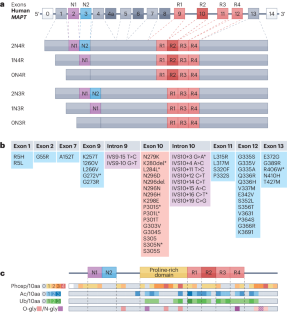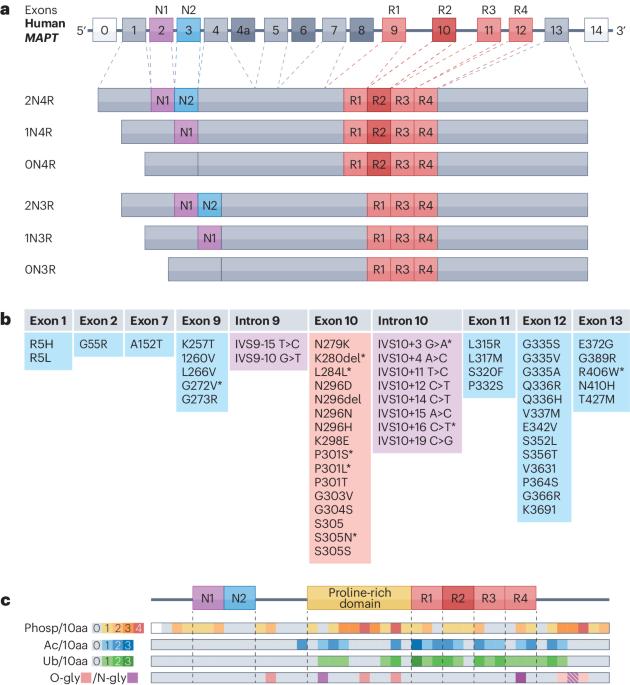Cellular and pathological functions of tau
IF 81.3
1区 生物学
Q1 CELL BIOLOGY
引用次数: 0
Abstract
Tau protein is involved in various cellular processes, including having a canonical role in binding and stabilization of microtubules in neurons. Tauopathies are neurodegenerative diseases marked by the abnormal accumulation of tau protein aggregates in neurons, as seen, for example, in conditions such as frontotemporal dementia and Alzheimer disease. Mutations in tau coding regions or that disrupt tau mRNA splicing, tau post-translational modifications and cellular stress factors (such as oxidative stress and inflammation) increase the tendency of tau to aggregate and interfere with its clearance. Pathological tau is strongly implicated in the progression of neurodegenerative diseases, and the propagation of tau aggregates is associated with disease severity. Recent technological advancements, including cryo-electron microscopy and disease models derived from human induced pluripotent stem cells, have increased our understanding of tau-related pathology in neurodegenerative conditions. Substantial progress has been made in deciphering tau aggregate structures and the molecular mechanisms that underlie protein aggregation and toxicity. In this Review, we discuss recent insights into the diverse cellular functions of tau and the pathology of tau inclusions and explore the potential for therapeutic interventions. Tau is a microtubule-binding protein that is expressed primarily in neurons. The abnormal accumulation of tau aggregates in neurons is associated with neurodegenerative diseases, known as tauopathies, such as Alzheimer disease and frontotemporal dementia. This Review discusses recent insights into the diverse cellular functions of tau, the pathology of tau aggregates and the potential for therapeutic interventions.


tau 的细胞和病理功能
Tau 蛋白参与了多种细胞过程,包括在神经元中结合和稳定微管的典型作用。Tau病是一种神经退行性疾病,其特征是tau蛋白在神经元中的异常聚集,如额颞叶痴呆症和阿尔茨海默病。tau编码区的突变或破坏tau mRNA剪接的突变、tau翻译后修饰和细胞应激因素(如氧化应激和炎症)会增加tau聚集的倾向并干扰其清除。病理性 tau 与神经退行性疾病的进展密切相关,而 tau 聚集体的扩散与疾病的严重程度有关。最近的技术进步,包括低温电子显微镜和从人类诱导多能干细胞中提取的疾病模型,增加了我们对神经退行性疾病中与 tau 相关的病理的了解。我们在破译 tau 聚集结构以及蛋白质聚集和毒性的分子机制方面取得了重大进展。在这篇综述中,我们将讨论有关 tau 的多种细胞功能和 tau 包涵体病理学的最新见解,并探讨治疗干预措施的潜力。
本文章由计算机程序翻译,如有差异,请以英文原文为准。
求助全文
约1分钟内获得全文
求助全文
来源期刊
CiteScore
173.60
自引率
0.50%
发文量
118
审稿时长
6-12 weeks
期刊介绍:
Nature Reviews Molecular Cell Biology is a prestigious journal that aims to be the primary source of reviews and commentaries for the scientific communities it serves. The journal strives to publish articles that are authoritative, accessible, and enriched with easily understandable figures, tables, and other display items. The goal is to provide an unparalleled service to authors, referees, and readers, and the journal works diligently to maximize the usefulness and impact of each article. Nature Reviews Molecular Cell Biology publishes a variety of article types, including Reviews, Perspectives, Comments, and Research Highlights, all of which are relevant to molecular and cell biologists. The journal's broad scope ensures that the articles it publishes reach the widest possible audience.

 求助内容:
求助内容: 应助结果提醒方式:
应助结果提醒方式:


